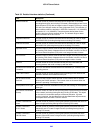
239
XS712T Smart Switch
The following table describes the detailed port information displayed on the screen.
Table 39. Detailed interface statistics
Field Description
ifIndex This field indicates the ifIndex of the interface table entry associated with this
port on an adapter.
Port Type For most ports this field is blank. Otherwise the possible values are:
• Mirrored. Indicates that the port has been configured as a monitoring port
and is the source port in a port mirroring session. For additional
information about port monitoring and probe ports, see
Mirroring on
page 256.
• Probe. Indicates that the port has been configured as a monitoring port
and is the destination port in a port mirroring session. For additional
information about port monitoring and probe ports, see
Mirroring on
page 256.
• Port Channel. Indicates that the port has been configured as a member
of a port-channel, which is also known as a Link Aggregation Group
(LAG).
Port Channel ID If the port is a member of a port channel, the port channel's interface ID and
name are shown. Otherwise, Disable is shown.
Port Role Each MST Bridge Port that is enabled is assigned a Port Role for each
spanning tree. The port role will be one of the following values: Root Port,
Designated Port, Alternate Port, Backup Port, Master Port, or Disabled Port.
STP Mode Displays the Spanning Tree Protocol (STP) Administrative Mode for the port or
LAG. The possible values for this field are:
• Enable. Enables the Spanning Tree Protocol for this port.
• Disable. Disables the Spanning Tree Protocol for this port.
STP State Displays the port's current state Spanning Tree state. This state controls what
action a port takes on receipt of a frame. If the bridge detects a malfunctioning
port it will place that port into the broken state. The other five states are
defined in IEEE 802.1D:
• Disabled
• Blocking
• Listening
• Learning
• Forwarding
• Broken
Admin Mode Displays the port control administration state:
• Enable. The port can participate in the network (default).
• Disable. The port is administratively down and does not participate in the
network.
Flow Control Mode Indicates whether flow control is enabled or disabled for the port. This field is
not valid for LAG interfaces.


















